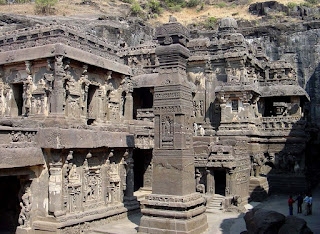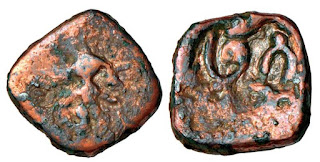Rashtrakuta Dynasty had been a royal Indian dynasty ruling large parts of Southern, Central and Northern India between the sixth and the tenth centuries. During that period they ruled as several closely related, but individual clans. The earliest inscriptions come from the seventh century copper plate that mentions their rule in the Malwa region. Other Rashtrakuta clans mentioned in inscriptions had been the kings of Achalapur, modern Elichpur in Maharashtra and the rulers of Kannauj.
Rashtrakutas, Guna Tunga, 8th century coin
The name ''Rashtrakuta'' in Sanskrit means Country (Rashtra) and Chieftain (Kuta). This explains their lineage from the time of the Mauryan Emperor Ashoka the Great (3rd century BC). In some of the edicts of Ashoka, the word Rathika appears, who may have been the ancestors of the Rashrakutas. Dantidurga established the Rashtrakuta Empire in 753 AD.
At the same time the Pala dynasty of Bengal and the Prathihara dynasty of Gujarat came to power in eastern and northwestern India. The period between the eight and the tenth dynasty saw a tripartite struggle for the Gangetic plains. At their peak the Rashtrakutas ruled a vast empire stretching from the Ganga river and Yamuna river doab in the north to Kanyakumari in the south.
Rastrakutas Empire, 753-982 AD
Dantidurga was succeeded by Krishna I (his uncle). He expanded the territory and was the man behind the construction of the exquisite Kailasa Temple of Ellora. The ascension of Dhruva Dharavarsha, 780-793 AD marks the golden period for their empire. He defeated the Gurjara-Pratihara Kingdom of Central India and the Pala Kingdom of Eastern India which was centered around the present day Bengal and thus started the tripartite struggle to control the main heartland of India. Subsequently, Govinda III, expanded the kingdom till Kanyakumari.
Kailasha Temple, Ellora
During their rule, Jain mathematicians and scholars contributed important works in Kannada and Sanskrit. Amoghavarsha I (814-878 AD) the famous king and son of Govinda III, who ruled for 61 years, was a scholar king who wrote Kavirajamarga, a landmark literary in Kannada language. Architecture reached a milestone and can be seen at Ellora caves in Maharashtra and the Jain temple in Karnataka, both UNESCO Heritage Sites.
Jain Narayana temple at Pattadakal, Karnataka
The Rashtrakutas divided their kingdom into provinces and further into districts. A hierarchy was followed from the king to the Chief Minister to a cabinet of ministers. The empire had a mighty army divided into infantry, cavalry and elephants. Trade was flourishing with Arabia and Persia.
They patronized Kannada and Sanskrit, which was the language of the elite.
Kashishvanatha temple at Pattadakal, Karnataka
Old Kannada Inscription, 780 AD, of King Dhruva Dharavarsha, Naregal
Their decline began from 972 AD after Khottiga Amoghavarsha was defeated by a Parmara dynasty ruler. The capital Manyakheta was plundered and looted. The last ruler, Indra IV took his own life in 982 AD by performing a Jaina ritual called Sallekhana, which is a fast to death. Their areas were annexed by the later Cholas and other dynasties.
Gujarat Region, Krishna I, Akalavarsha, 756-778 AD, copper, weight 1.5 gm, Obverse: Indistinct motif, Reverse: Brahmi legend, Shri Ga (na)
Dantidurga, 735-756 AD, Central Maharashtra type, weight 2.3 gm, Obverse: Figure of Garuda standing facing, below a crescent in a dotted border, Reverse: Brahmi legend Shri Khadgavaloka
Dhruva Dharavarsha, 780-793 AD, alloy copper, Central Maharashtra type, weight 2.6 gm, Obverse: Figure of Garuda standing facing, Reverse: Retrograde Brahmi legend Nirupa



















No comments:
Post a Comment
Any inputs or feedback is welcome!